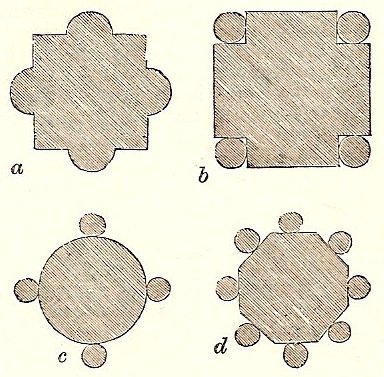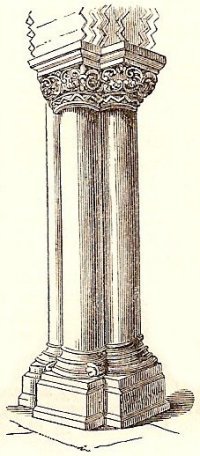pillar

Figure 2.
Cross-sections of various types of pillar.
A pillar is a detached support like a column; but its section may be any shape, whereas the column is always round. Pillars have been used in all styles of architecture, and their form and ornaments are usually among the most characteristic features of the style.
The Greek and Roman pillars (or columns) are the distinguishing elements in the various orders. In Gothic architecture, also, the pillars or piers are of different forms at the various epochs of that style. In the Norman period we have plain massive pillars, square, circular, and octagonal, frequently ornamented with zigzag ornaments, spiral bands, etc, on the surface (Figure 1).
 |
| Figure 1. Norman clustered pillar |
As vaulting progressed, the system of breaking the plain surface of the pier, and giving to each portion of the vaulting a separate little column or shaft to support it was introduced. This was done either by attaching shafts to the pillars, or by cutting nooks in the pillars and setting little shafts in them (Figure 2a and b). In the Early Pointed style a plain circular or octagonal pillar, with a number of small shafts attached around it, is a favorite arrangement (Figure 2c and d). In this style the attached shafts are very frequently banded to the main pillar at different heights, and they are sometimes made of a finer material, such as Purbeck marble.
In the Decorated style the pillar is of a lozenge form, and not so much ornamented with detached shafts as with moldings; plain, circular, or octagonal pillars, however, are used in this, as in all the styles. The moldings and shafts are usually filleted; and some of the moldings run up into the arch without any cap. In Perpendicular the same idea is further carried out; the moldings become thinner, and are more frequently run up into the arch without caps.
